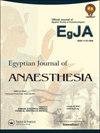The effect of combined ultrasound-guided transverse thoracic muscle plane block and rectus sheath plane block on the peri-operative consumption of opioids in open heart surgeries with median sternotomy
IF 0.5
Q3 ANESTHESIOLOGY
引用次数: 0
Abstract
ABSTRACT Background Patients undergoing heart surgery with a midline sternotomy typically get intravenous opioids as their primary form of post-operative pain management. Due to its possible drawbacks, regional neuraxial anesthesia is still controversial. There have been reports on the impact of rectus sheath plane (RSP) block in conjunction with ultrasound-guided transverse thoracic muscle plane (TTP) block on postoperative pain following sternotomy. Aim Of The Study The efficiency of combining TTP and RSP blocks in lowering the targeted patients’ perioperative requirement for opioids, minimizing opioid adverse effects, and attaining a potential Fast-Tract Extubation. Patients And Methods 50 patients undergoing open cardiac surgery via median sternotomy were randomly assigned to one of two groups in this randomized, prospective, comparative trial. Group (B) got combined ultrasound-guided TTP and RSP blocks, while Group (S) received saline in the same planes before to the incision. Results There was no significant difference between the groups for the demographic information, postoperative opioid consumption, or VAS pain scores, however there was a very significant difference between the groups for intraoperative opioid intake and time to extubation. Conclusion Combining TTP and RSP blocks has improved fast-track extubation, decreased hemodynamic changes in response to surgical stress, and decreased intraoperative opioid usage. The blocks directed by routine pain score evaluation did not, however, have a significant impact on postoperative opioid use.超声引导下胸横肌平面阻滞和直肌鞘平面阻滞联合应用对正中胸骨切开术围手术期阿片类药物消耗的影响
本文章由计算机程序翻译,如有差异,请以英文原文为准。
求助全文
约1分钟内获得全文
求助全文
来源期刊

Egyptian Journal of Anaesthesia
Medicine-Anesthesiology and Pain Medicine
CiteScore
0.90
自引率
0.00%
发文量
78
 求助内容:
求助内容: 应助结果提醒方式:
应助结果提醒方式:


